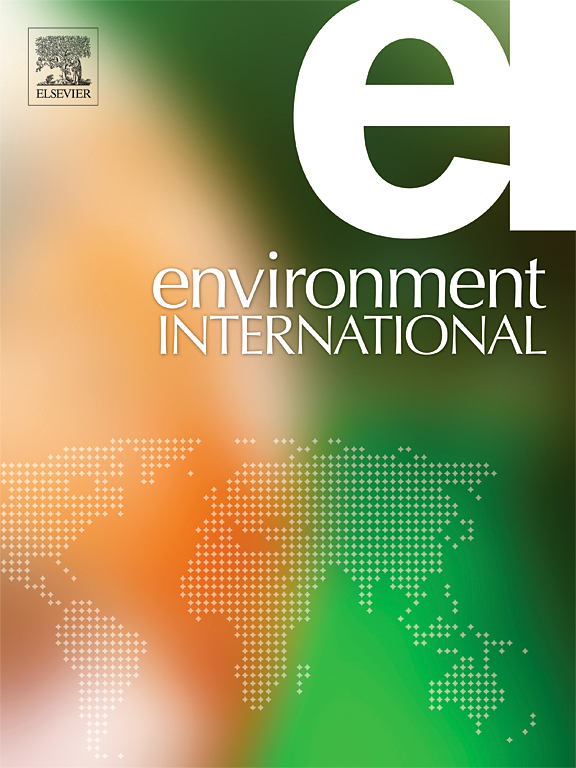Development of SOA modules in the WRF-Chem model and evaluation of the key formation pathways of SOA and associated health risk over mainland China
IF 10.3
1区 环境科学与生态学
Q1 ENVIRONMENTAL SCIENCES
引用次数: 0
Abstract
Secondary Organic Aerosol (SOA), a vital component of fine particulate matter (PM2.5), formation of which is significantly affected by precursors, meteorological factors and the levels of oxidants. However, identifying their roles in SOA and PM2.5, as well as quantifying the contributions of the individual pathway to SOA abundance still remain challenged due to the complex origins and degradation mechanisms, as well as the discrepancy between the simulated and observed SOA. Here, a commonly used WRF-Chem model was further optimized for SOA simulation. The improvements included the integration of primary emissions and the degradation of S/IVOCs, aqueous chemistry of carbonyl compounds, chlorine chemistry, cloud aqueous chemistry, and SOA wet deposition processes. The optimized model was used to evaluate the key SOA formation pathways and their impact factors, as well as the associated health risk during pollution episodes. The dominant factors of the aqueous chemistry of carbonyl compounds, chlorine chemistry module, Cl-initiated SOA-forming pathway, cloud aqueous chemistry and wet deposition that influenced SOA abundance were aerosol water, volatile organic compounds (VOCs), Cl atom, temperature, respectively. The key formation pathways leading to SOA pollution were the gas-phase oxidation of semi-volatile/intermediate-volatility organic compounds (S/IVOCs) and the aqueous-phase chemistry of carbonyl compounds over mainland China. The regional average attributable fraction of mortality was approximately 0.03, with the largest contributions from the reaction pathways of S/IVOCs and carbonyl compounds. Therefore, reducing emissions of S/IVOCs and carbonyl compounds is vital to mitigating SOA and PM2.5 concentrations, achieving air quality standards, and protecting public health.


WRF-Chem模型中SOA模块的开发以及对中国大陆SOA关键形成途径和相关健康风险的评估
二次有机气溶胶(SOA)是细颗粒物(PM2.5)的重要组成部分,其形成受前体、气象因素和氧化剂水平的显著影响。然而,由于复杂的起源和退化机制,以及模拟和观察到的SOA之间的差异,确定它们在SOA和PM2.5中的作用,以及量化单个途径对SOA丰度的贡献仍然存在挑战。这里,一个常用的WRF-Chem模型针对SOA模拟进行了进一步优化。这些改进包括一次排放和S/IVOCs降解的整合、羰基化合物的水化学、氯化学、云水化学和SOA湿沉积工艺。利用优化后的模型评估了污染期间SOA形成的关键路径及其影响因子,以及相关的健康风险。羰基化合物水化学、氯化学模块、Cl引发的SOA形成途径、云水化学和湿沉积影响SOA丰度的主要因素分别是气溶胶水、挥发性有机化合物(VOCs)、Cl原子和温度。导致中国大陆地区SOA污染的关键形成途径是半挥发性/中间挥发性有机化合物(S/IVOCs)的气相氧化和羰基化合物的水相化学。区域平均死亡归因分数约为0.03,S/IVOCs和羰基化合物的反应途径贡献最大。因此,减少S/IVOCs和羰基化合物的排放对于降低SOA和PM2.5浓度、达到空气质量标准和保护公众健康至关重要。
本文章由计算机程序翻译,如有差异,请以英文原文为准。
求助全文
约1分钟内获得全文
求助全文
来源期刊

Environment International
环境科学-环境科学
CiteScore
21.90
自引率
3.40%
发文量
734
审稿时长
2.8 months
期刊介绍:
Environmental Health publishes manuscripts focusing on critical aspects of environmental and occupational medicine, including studies in toxicology and epidemiology, to illuminate the human health implications of exposure to environmental hazards. The journal adopts an open-access model and practices open peer review.
It caters to scientists and practitioners across all environmental science domains, directly or indirectly impacting human health and well-being. With a commitment to enhancing the prevention of environmentally-related health risks, Environmental Health serves as a public health journal for the community and scientists engaged in matters of public health significance concerning the environment.
 求助内容:
求助内容: 应助结果提醒方式:
应助结果提醒方式:


